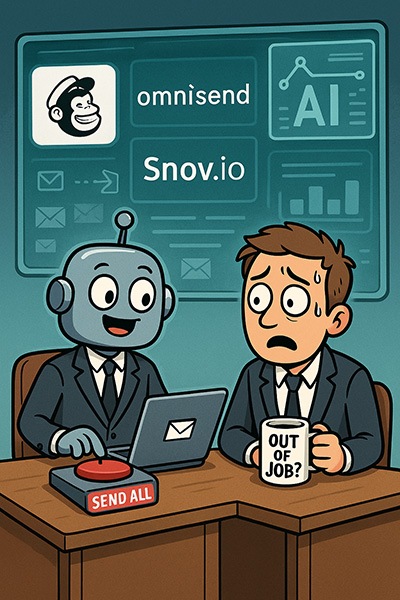Introduction
You’ve probably seen the headlines.
“AI has taken over email marketing. Human marketers are no longer needed.”
Scary, right?
But let’s pause. Is it really the end of email marketers? Or is this just another case of hype vs reality?
Here’s the truth: AI is changing how email campaigns are built, automated, and optimized. It’s faster, smarter, and sharper than ever. Yet, does that mean marketers can pack their bags? Not so fast.
In this blog, I’ll break down the role of AI in email marketing, how it addresses pain points, tools that are leading the change, and why—despite the noise—email marketing isn’t dying.
Instead, it’s evolving.
The AI Revolution in Email Marketing
AI in email marketing is not just about automation anymore. It’s about predicting behavior, segmenting better, and personalizing at scale.
Think of it like this:
- Before AI → You’d manually write subject lines, test them, and hope they worked.
- With AI → Tools generate subject lines, test variations, and tell you which one wins—all in minutes.
Real-world Example:
A clothing brand used AI to analyze open rates. Instead of sending one generic newsletter, AI segmented audiences into micro-groups. Some got product recommendations, others got style tips. The result? A 35% lift in sales in just one quarter.
So yes, AI is powerful. But it didn’t decide the tone of the campaign. A marketer still directed the strategy.
Why People Think Email Marketers Are No Longer Needed
- AI Can Generate Content
AI copy tools write subject lines, email bodies, and CTAs. It feels like the job is done. - AI Can Segment Audiences
Machine learning identifies buyer personas with incredible precision. - AI Can Automate Follow-ups
Sequences run without human touch.
All this sounds like email marketers are out of the picture. But here’s the catch—AI lacks context, empathy, and big-picture vision.
It knows what works statistically, not why it matters emotionally.
Why Email Marketing Is Not Dying
Here’s where the focus keyword fits perfectly: why email marketing is dying.
People assume it’s dying because automation tools reduce the need for manual work. But email marketing is alive and thriving. The only thing “dying” is outdated strategies.
- Old newsletters without personalization? Dead.
- Spammy cold outreach? Dead.
- One-size-fits-all campaigns? Dead.
But smart, AI-powered + human-driven email marketing? That’s the future.
Pain Points That AI Actually Solves
Marketers often complain about:
- Low open rates
- Poor engagement
- Too much time spent on A/B testing
- Weak personalization
- Manual segmentation
AI solves these problems with:
- Predictive subject lines
- Smart send-time optimization
- Audience clustering
- Automated testing
- Behavior-based triggers
Still, someone needs to decide the tone, strategy, and storytelling. That’s where humans shine.
Tools That Show How AI Has Changed Email Marketing
Here are some tools worth mentioning:
- Snov.io – Great for cold outreach automation with AI-driven personalization.
- Instantly – Fast, scalable campaigns with built-in AI optimizers.
- Mailchimp – AI recommendations for subject lines, send times, and more.
- Omnisend – Smart segmentation and predictive analytics.
- MailerLite – Easy-to-use AI-based automation for small businesses.
These tools save time, reduce guesswork, and improve ROI. But none of them can replace human creativity.
Example Scenarios
Scenario 1: AI Without Human Touch
Imagine an AI writing 100 cold outreach emails. They’re grammatically correct, but all feel robotic. The result? Few replies.
Scenario 2: Human + AI Collaboration
Now imagine you, the marketer, guiding AI. You tweak tone, add empathy, and personalize context. The result? Warm responses and actual conversions.
See the difference?
FAQs About AI in Email Marketing
1. Will AI completely replace email marketers?
No. AI handles automation and analysis. Humans handle strategy, storytelling, and empathy.
2. Can AI write subject lines better than humans?
Sometimes, yes. But it can’t always capture humor, sarcasm, or cultural nuance.
3. Is AI expensive for small businesses?
Not anymore. Tools like MailerLite and Omnisend offer affordable AI features.
4. Why do people say email marketing is dying?
Because traditional spammy tactics don’t work anymore. But personalized, AI + human-driven campaigns are booming.
5. What’s the biggest risk of relying only on AI?
Losing authenticity. Your brand voice may sound generic.
Tips for Marketers to Stay Ahead in the AI Era
- Learn AI Tools – Understand features, but don’t rely blindly.
- Focus on Storytelling – AI can’t replace emotional connection.
- Experiment More – Use AI for data-driven tests, then apply human judgment.
- Personalize Deeply – Blend AI segmentation with human insights.
- Think Strategy, Not Just Execution – AI executes. You innovate.
Industry Innovations to Watch
- AI Predictive Analytics – Guessing what customers want before they even know.
- AI Voice + Email Integration – Smart assistants drafting follow-ups.
- Hyper-Personalization at Scale – Emails that feel 1:1, even when sent to 10,000.
- AI-Powered Cold Outreach – Predicting which prospects are most likely to reply.
Conclusion
AI has transformed email marketing. It handles the heavy lifting—segmentation, subject lines, send times, and testing. That’s why so many think “why email marketing is dying.”
But the truth? Email marketing is not dying. It’s evolving.
AI is a tool. The marketer is the strategist. Together, they’re unstoppable.
And if you’re wondering how to set up smart, scalable campaigns that mix AI efficiency with human creativity, I can help.
I’m Yusuf Rangwala, an email marketing specialist. I help businesses set up cold outreach and email campaigns using tools like Snov.io, Instantly, Mailchimp, Omnisend, and MailerLite.
With the right mix of AI tools and strategy, your emails won’t just land in inboxes—they’ll create lasting impact.

